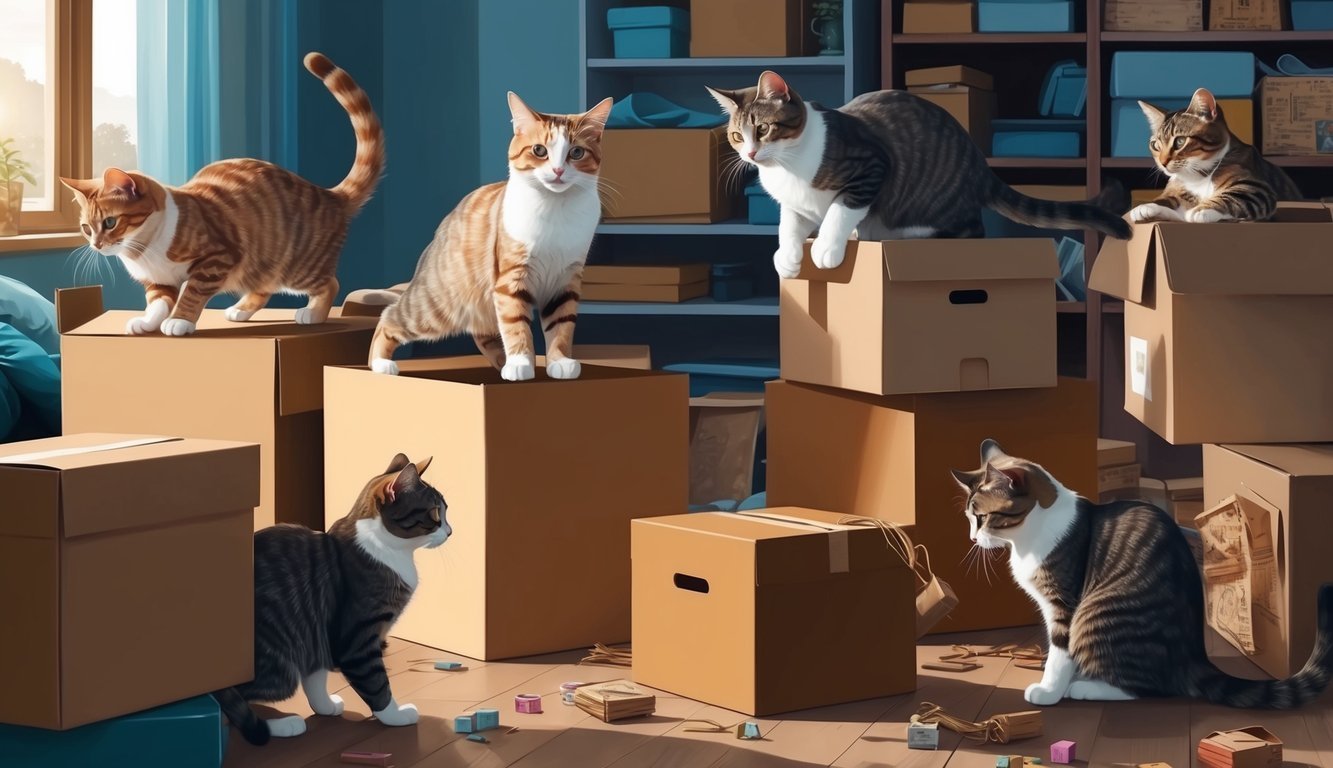Cats have an undeniable affinity for boxes, leading many cat owners to wonder why these seemingly simple structures hold such fascination. Cats are naturally drawn to boxes because they provide security, a sense of comfort, and a means to engage in playful behavior.
When a cat sees a box, it triggers instincts rooted in their wild ancestry, where small, enclosed spaces offer protection from predators and an ideal spot for stalking prey.
Beyond safety, boxes serve as playgrounds for your feline friend, allowing them to express their curiosity and playful nature.
Whether they are hiding, pouncing, or simply lounging, boxes fulfill several of their needs in one compact package.
Understanding this behavior can help enhance your cat’s environment, ensuring they remain happy and stimulated.
Creating a cat-friendly space with boxes can reshape your home life with your pet.
So, the next time you receive a delivery, think twice before tossing out the box.
Your cat might just consider it their new favorite hangout.
Key Takeaways
- Cats find comfort and security in enclosed spaces like boxes.
- Playing in boxes allows cats to express their natural instincts.
- Providing boxes can enhance your cat’s overall happiness and well-being.
The Feline Fascination with Boxes
Cats possess a natural inclination toward enclosed spaces, which can be traced back to their instincts as ambush predators.
Understanding this behavior can enrich your bond with your domestic cat.
Here’s how boxes play a vital role in their lives.
Natural Instincts
Your cat’s fascination with boxes stems from their ancestors, both domestic and wild, who thrived in enclosed spaces.
As ambush predators, lions, tigers, and other big cats often use concealment to stalk prey.
In your home, a box becomes a safe hiding spot, catering to these ingrained instincts.
It allows your cat to observe the world around them while feeling hidden and secure.
This behavior is not just about comfort; it’s deeply rooted in survival tactics.
Security and Comfort
Cats are creatures of habit and can easily become anxious when faced with unfamiliar situations.
A box offers your cat a cozy retreat where they can escape stressors.
The enclosed nature of a box creates a sense of security.
When they crawl into a box, they often enter a self-made cocoon where they can relax.
This comfort is crucial for their well-being, giving them a controlled environment to retreat to whenever they feel threatened or anxious.
Stress Relief and Adaptation in Shelter Cats
The presence of boxes proves to be beneficial, especially for shelter cats.
Studies indicate that hiding spaces significantly reduce stress levels in these animals.
When you provide boxes in an animal shelter, it helps cats adapt to their surroundings.
They are more likely to feel secure, allowing them to explore and interact with their environment at their own pace.
This leads to healthier behavioral patterns and a better chance of being adopted.
Whether you’re fostering a shelter cat or living with a domestic one, recognizing the importance of boxes can enhance their emotional health and overall happiness.
Cardboard Boxes: More Than Just a Box
Cardboard boxes offer more than mere shelter for your cat; they provide a source of joy and enrichment.
These simple structures can enhance your cat’s environment and stimulate their natural instincts in various ways.
The Simple Joy of Cardboard
Cats thrive on novelty and simplicity, and cardboard boxes are perfect for that.
When you introduce a box into your home, watch how your cat immediately inspects it.
The enclosed space appeals to their instinct to seek security.
Boxes are also fun for cats to scratch and chew, which helps maintain their claws.
You might even notice them spending hours nestled inside a box, peeking out, and observing their surroundings.
This behavior mimics their natural hunting instincts, where stealth and surprise play crucial roles.
Boxes as Enrichment Tools
Using cardboard boxes as enrichment tools can significantly benefit your cat’s well-being.
Research indicates that boxes provide a sense of security and can reduce stress levels.
Think of a box as an enrichment center for your feline friend.
You can add puzzle pieces or challenges to the mix, turning a simple box into a game board.
This not only engages their concentration but also encourages problem-solving and planning skills.
In the Netherlands, studies have shown that shelter cats who were given boxes adapted better to new environments.
This illustrates how essential cardboard boxes can be for emotional stability and mental health.
Interactive Play and Learning
You can transform a cardboard box into an interactive playground.
Use it creatively by cutting holes or adding small toys inside.
This promotes spatial insight as your cat learns to navigate their new “hunting ground.”
Consider creating a challenge booklet with tasks for your cat.
Use the box as a starting point for games involving hiding treats or toys.
This stimulates their problem-solving abilities while keeping them physically active.
With some planning, you can turn ordinary boxes into engaging spaces that captivate your cat’s attention.
Each interaction becomes a learning experience, enhancing both their mental and physical agility.
Understanding Cat Behavior
Cats are fascinating creatures with unique behaviors, especially when it comes to their love for boxes.
Their actions can often seem puzzling, but understanding the reasons behind these behaviors reveals the complexities of their inner minds.
Decoding Box-Related Behaviors
When you observe your cat gravitating towards boxes, know it’s not just a random preference.
Boxes provide a sense of security and comfort.
In the wild, cats seek shelter in tight spaces to protect themselves from predators.
Similarly, your cat may feel safe nesting in a box.
Aside from security, boxes serve practical purposes for your feline.
They provide an ideal surface for scratching and marking territory, which keeps their claws healthy.
Additionally, boxes can help reduce anxiety, especially in stressful environments.
A study suggested that having access to boxes can lower stress levels in shelter cats, proving their importance beyond mere play.
The Inner Workings of the Feline Mind
Understanding your cat’s behavior also means tapping into the logic of the feline mind.
Cats are naturally curious, and a box presents an intriguing opportunity to explore.
They enjoy the tactile sensations and the ability to retreat without the fear of being disturbed.
You might notice your cat exhibiting a mix of playfulness and anxiety relief when they interact with boxes.
This duality stems from their instinctual need for both stimulation and security.
Recognize that your cat’s behavior is influenced by environmental changes, daily routine, and personal temperament.
By providing various box options, you can cater to their individual preferences, enhancing their overall well-being.
Frequently Asked Questions
Many cat owners wonder about the allure of cardboard boxes for their feline friends.
Here are some responses to common inquiries regarding cats and their box fascination.
Why do cats have a fascination with cardboard boxes?
Cats naturally seek shelter and safe spaces.
Cardboard boxes provide a secure environment where they can hide and feel protected.
The texture of the cardboard also appeals to their instinct to scratch and chew.
What kind of boxes are safe for cat play?
When choosing boxes for your cat, opt for sturdy cardboard without sharp edges or staples.
Avoid boxes that are treated with chemicals or have toxic inks.
Basic shipping boxes or plain, unused boxes work best.
How can you turn a cardboard box into a cat toy?
You can transform a cardboard box into a toy by cutting small holes for your cat to peek through.
Adding crinkly paper or dangling toys inside can also enhance the fun.
Just ensure there are no loose pieces that could be swallowed.
What are some tips for choosing the right box for my cat?
Select a box that is large enough for your cat to move around comfortably.
Consider their personality; playful cats might enjoy a larger box for exploration, while shy cats prefer smaller, enclosed spaces.
Ensure the box is stable and won’t tip over easily.
Can playing in boxes have benefits for a cat’s well-being?
Yes, playing in boxes can provide mental stimulation and encourage natural behaviors like stalking and hiding.
It also helps reduce anxiety by giving cats a personal space.
Engaging with boxes can lead to increased physical activity and overall happiness.
How do cats react differently to boxes compared to traditional cat beds?
Cats often prefer boxes for their security and warmth, which may not be as pronounced in traditional beds.
A box allows them to observe their surroundings while feeling protected.
Beds, while comfortable, may not provide the same level of security that a box does.


